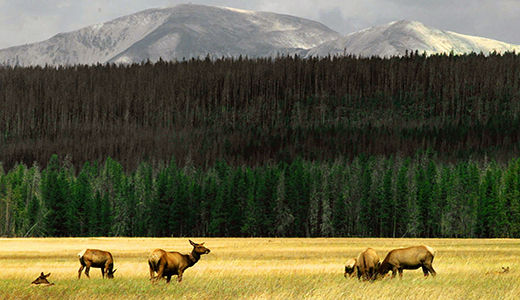
Today marks the 99th anniversary of the National Park Service, and it could prove the right time for careful reflection. The agency is waiving the entrance fee this month for all 408 of its national parks, monuments, and other protected sites, including iconic landmarks like Mount Rushmore and the Grand Canyon. But the move can be seen as a pushback against young peoples’ increasing disconnect from nature. At the same time, national parks face dual attacks, in the form of legislation meant to destroy them, and climate change, which could pose a similar threat.
The National Park Service was founded on August 25, 1916, when President Woodrow Wilson signed the National Park Service Organic Act into law, which would “conserve the scenery and the natural and historical objects and wildlife therein, and provide for the enjoyment of the same in such a manner as will leave them unimpaired for the enjoyment of future nations.” The legislation had heavily been pushed for by conservationist and Sierra Club member Stephen Mather, who was subsequently appointed as the first director of the National Park Service. According to a bronze plaque at Utah’s Zion National Park, Mather “laid the foundation” for the agency, “defining and establishing the policies under which its areas shall be developed and conserved.”
Today, national parks enjoy the benefit of that conservation. But while their early history contained a note of hope, recent times have proven tumultuous for the supposedly protected sites. On one hand, these parks saw high visitation last year, contributing $29.7 billion to the economy and supporting 277,000 jobs. But on the other, apparently not many of those visitors were of the younger generation. For this reason, the National Park Service recently launched a “Find Your Park” campaign designed to connect more kids with these public lands. Launched on Mar. 30 this year, the campaign is intended to help people find those national parks that are closest to where they live. First Lady Michelle Obama hosted a video in connection with the movement, noting her own family’s connection to the Pullman National Monument in Chicago.
Despite campaigns like these, a lack of consideration for national parks is also evident amongst Congress, as these places continue to be plagued by financial burdens. The National Park Service is currently operating under an $11.5 million maintenance backlog, which has caused facilities and park infrastructure to age. Park roads and bridges alone account for at least half of that backlog, according to National Parks Traveler. The agency received some of its operational funding through the Federal Lands Transportation Program, but that expired in May, and Congress has not considered alternative ways to fund parks.
Craig Obey, National Park Service’s senior vice president of governmental affairs, said, “As the centennial of the National Park Service approaches in 2016, we hope Congress will work in a bipartisan fashion to support ‘America’s best idea.’ Now is the time to reinvest in our national parks, through both traditional and creative new approaches.”
But ‘bipartisan’ doesn’t look as though it will be a word used in coming discussions, as Rep. Don Young, R-Ark., introduced legislation on Jan. 13 that would make preserving lands and monuments a thing of the past. Called H.R. 330, the bill would amend the 1906 Antiquities Act to block the president from designating new national monuments without congressional approval and an “extensive environmental review.” It would also require the president to get similar approval for marine monuments.
“Americans value national parks,” said Alex Taurel, deputy legislative director for the League of Conservation Voters. “But this legislation would attack the century-old law that has helped protect them. By introducing it, Rep. Young has proven how out of step with the American people he is.” Given the fact that recent polling data demonstrates that 70 percent of voters support the efforts of President Obama to protect new monuments for future generations, those words likely ring quite true.
Finally, national parks must contend with the ever looming portent of climate change. A new report has shown that up to one quarter of the total combined land area of national parks was especially vulnerable to global warming’s effects, factoring in elements such as wildlife relocation and dislocation.
“We already established that climate change and habitat loss affect national parks, but this scientific study links these negative effects and identifies just how much of the landscape is at risk,” said National Park Service director Jonathan B. Jarvis. “The good news is that the study also identified areas of biodiversity that are refuges and wellsprings for species.”
Part of the chaos caused by the changing climate is, of course, a steady increase in wildfires, and for myriad reasons, that is a complex issue in and of itself. There are currently at least 167 such fires burning across the U.S., with an infamously memorable blaze occurring in Yosemite National Park in 2013. And much like the National Park Service, the U.S. Forest Service has experienced crippling funding cuts and limited access to safety equipment. The agency now spends more than 50 percent of its budget on firefighting alone, and scientists say the fires are only going to get worse.
With so many attacks on all sides, the National Park Service’s best bet is to renew interest in the lands it has helped protect, so that the fightback on the part of environmentalists and conservationists will be that much greater.
“The National Park Service’s 99th birthday is an opportunity to celebrate the role of national parks in the American story,” Jarvis concluded. “And it’s also a time to look ahead to our centennial year, and the next 100 years. These national treasures belong to all of us, and we want everyone – especially the next generation of park visitors, supporters, and advocates – to discover and connect with their national parks.”
Photo: A herd of elk graze in a meadow at Yellowstone National Park. | AP










